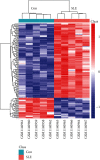IFN- γ Mediates the Development of Systemic Lupus Erythematosus
- PMID: 33123584
- PMCID: PMC7586164
- DOI: 10.1155/2020/7176515
IFN- γ Mediates the Development of Systemic Lupus Erythematosus
Abstract
Objective: Systemic lupus erythematosus (SLE) is a chronic autoimmune disease that can affect all organs in the body. It is characterized by overexpression of antibodies against autoantigen. Although previous bioinformatics analyses have identified several genetic factors underlying SLE, they did not discriminate between naive and individuals exposed to anti-SLE drugs. Here, we evaluated specific genes and pathways in active and recently diagnosed SLE population.
Methods: GSE46907 matrix downloaded from Gene Expression Omnibus (GEO) was analyzed using R, Metascape, STRING, and Cytoscape to identify differentially expressed genes (DEGs), enrichment pathways, protein-protein interaction (PPI), and hub genes between naive SLE individuals and healthy controls.
Results: A total of 134 DEGs were identified, in which 29 were downregulated, whereas 105 were upregulated in active and newly diagnosed SLE cases. GO term analysis revealed that transcriptional induction of the DEGs was particularly enhanced in response to secretion of interferon-γ and interferon-α and regulation of cytokine production innate immune responses among others. KEGG pathway analysis showed that the expression of DEGs was particularly enhanced in interferon signaling, IFN antiviral responses by activated genes, class I major histocompatibility complex (MHC-I) mediated antigen processing and presentation, and amyloid fiber formation. STAT1, IRF7, MX1, OASL, ISG15, IFIT3, IFIH1, IFIT1, OAS2, and GBP1 were the top 10 DEGs.
Conclusions: Our findings suggest that interferon-related gene expression and pathways are common features for SLE pathogenesis, and IFN-γ and IFN-γ-inducible GBP1 gene in naive SLE were emphasized. Together, the identified genes and cellular pathways have expanded our understanding on the mechanism underlying development of SLE. They have also opened a new frontier on potential biomarkers for diagnosis, biotherapy, and prognosis for SLE.
Copyright © 2020 Wenping Liu et al.
Conflict of interest statement
The authors declare that there is no conflict of interest regarding the publication of this article.
Figures





Similar articles
-
Bioinformatics identification of key candidate genes and pathways associated with systemic lupus erythematosus.Clin Rheumatol. 2020 Feb;39(2):425-434. doi: 10.1007/s10067-019-04751-7. Epub 2019 Nov 1. Clin Rheumatol. 2020. PMID: 31673979
-
Bioinformatics analyses of gene expression profile identify key genes and functional pathways involved in cutaneous lupus erythematosus.Clin Rheumatol. 2022 Feb;41(2):437-452. doi: 10.1007/s10067-021-05913-2. Epub 2021 Sep 23. Clin Rheumatol. 2022. PMID: 34553293
-
Bioinformatics analysis of differentially expressed gene profiles associated with systemic lupus erythematosus.Mol Med Rep. 2018 Mar;17(3):3591-3598. doi: 10.3892/mmr.2017.8293. Epub 2017 Dec 18. Mol Med Rep. 2018. PMID: 29257335 Free PMC article.
-
Interferon pathway activation in systemic lupus erythematosus.Curr Rheumatol Rep. 2005 Dec;7(6):463-8. doi: 10.1007/s11926-005-0053-4. Curr Rheumatol Rep. 2005. PMID: 16303107 Review.
-
Use of type I interferon-inducible mRNAs as pharmacodynamic markers and potential diagnostic markers in trials with sifalimumab, an anti-IFNα antibody, in systemic lupus erythematosus.Arthritis Res Ther. 2010;12 Suppl 1(Suppl 1):S6. doi: 10.1186/ar2887. Epub 2010 Apr 14. Arthritis Res Ther. 2010. PMID: 20392292 Free PMC article. Review.
Cited by
-
Novel immunoprofiling method for diagnosing SLE and evaluating therapeutic response.Lupus Sci Med. 2022 Jun;9(1):e000693. doi: 10.1136/lupus-2022-000693. Lupus Sci Med. 2022. PMID: 35738802 Free PMC article.
-
Inflammatory Factors Driving Atherosclerotic Plaque Progression New Insights.J Transl Int Med. 2022 Apr 2;10(1):36-47. doi: 10.2478/jtim-2022-0012. eCollection 2022 Mar. J Transl Int Med. 2022. PMID: 35702179 Free PMC article.
-
Jak Inhibitors for Treatment of Autoimmune Diseases: Lessons from Systemic Sclerosis and Systemic Lupus Erythematosus.Pharmaceuticals (Basel). 2022 Jul 28;15(8):936. doi: 10.3390/ph15080936. Pharmaceuticals (Basel). 2022. PMID: 36015084 Free PMC article. Review.
-
Interferons in Systemic Lupus Erythematosus.Rheum Dis Clin North Am. 2021 Aug;47(3):297-315. doi: 10.1016/j.rdc.2021.04.001. Epub 2021 Jun 10. Rheum Dis Clin North Am. 2021. PMID: 34215365 Free PMC article. Review.
-
Tissue-Specific Variations in Transcription Factors Elucidate Complex Immune System Regulation.Genes (Basel). 2022 May 23;13(5):929. doi: 10.3390/genes13050929. Genes (Basel). 2022. PMID: 35627314 Free PMC article.
References
-
- Tsokos G. C. Systemic lupus erythematosus. The New England Journal of Medicine. 2011;22(365):2110–2121. - PubMed
MeSH terms
Substances
LinkOut - more resources
Full Text Sources
Medical
Research Materials
Miscellaneous

